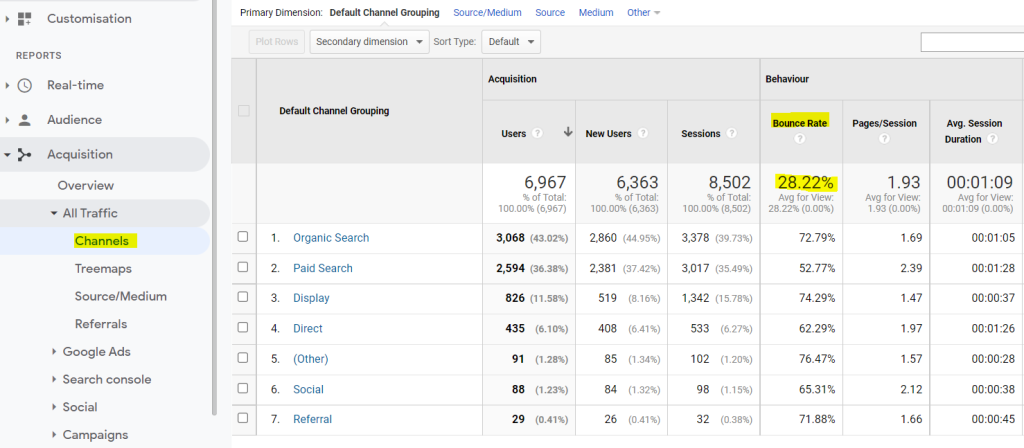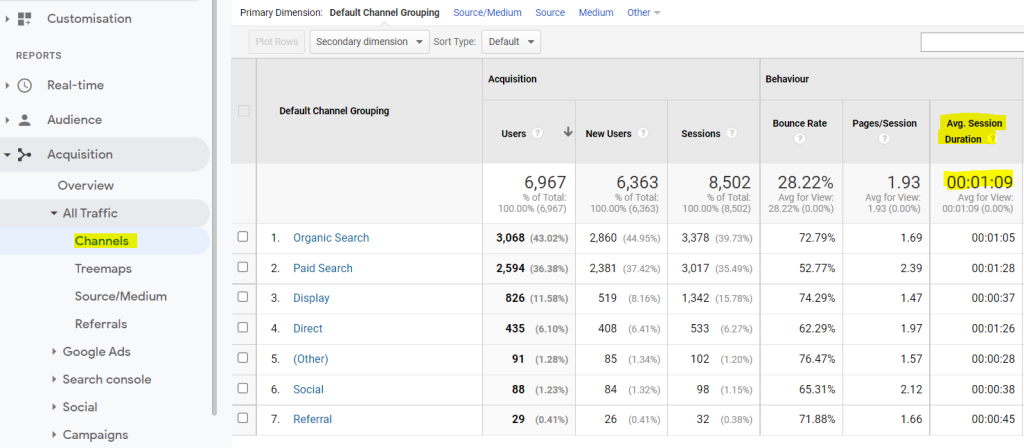Back
Why does my website have a high bounce rate?
Since the dawn of digital marketing, SEOs and data analysts have been tearing their hair out over high bounce rates.
Bounce rate measures the percentage of users that leave a website after viewing only one page. They exit the site without performing any actions. Google will register a session as a ‘bounce’, even if the user has been on the page for hours.
You can find out your website’s bounce rate, plus the bounce rate of individual web pages, via Google Analytics.

There are so many reasons why your website could have a high bounce rate, finding the root cause can feel disorientating. Thankfully, we’ve broken down the most crucial ones into a tight top 5. But first thing’s first:
What is a good bounce rate?
Here’s a quick bounce rate measuring system:
- 25% or under – This is actually too low, and something is probably wrong with the site.
- 26-40% – Perfect. The ideal bounce rate.
- 41-55% – Average. A majority of sites will show these figures.
- 56-70% – High, but not a cause for alarm if your site is particularly content-heavy, or primarily a source of information.
- 70% – This is too high, and is a sign that the site is underperforming, or perhaps even broken.
As you can see, having a slightly higher bounce rate can actually be a good thing. But what is causing your site to nudge over that 70% mark?
Slow page load times
In today’s online world, it’s all about getting facts as quickly as possible. This is why slow page loads are possibly the biggest contributor to a high bounce rate. Think about it: what’s the longest you’re willing to wait for a page to load before trying another website?
Shockingly, the human brain can detect delays as short as 1/10th of a second. Every second a customer waits for the page to load, they lose interest. They lose faith. They may even forget why they came to the page in the first place.
You can review your website speed in tools like Page Speed Insights or Lighthouse. These will give suggestions for improving load times. It’s often the case that image files need to be reduced.
Issues with content
Users will be put off by poorly written content. To avoid users from bouncing before they’ve even made it to the second paragraph, make sure you:
- Write in simple sentences
- Break up large paragraphs
- Include brief, easily summarisable headings
- Breaking up large quantities of information into lists (like this one!)
However, when it comes to content marketing, a high bounce rate can actually be a good thing. Your content may be effectively fulfilling the user’s needs, and they are bouncing off completely satisfied. The key metric to consider here is ‘session time’, or time on page. Again, this is something that can be investigated in Google Analytics.

If they’re only spending two or three seconds on the page, the content is probably putting them off. However, if they’re reading for a minute and then bouncing, you can assume that they have found the content useful. The average person reads 200-250 words a minute. So, you can roughly calculate how much they have read before exiting the site.
Discover what our content marketing team can do for you here.
Misleading page titles and meta description
Does your metadata accurately describe the purpose of the webpage? If not, users will arrive on the page with expectations not reflected in the content.
Misleading metadata will not increase your bounce rate, it will also annoy your audience. You don’t want to get a reputation as clickbait shovellers. Make sure your content is clear and consistent on every level.
Neglecting user experience
When you view SEO from a strictly technical point of view, it can be easy to over-optimise your site. Many websites are guilty of:
- Keyword stuffing
- Including too many CTAs, such as email newsletter sign-ups
- Filling the page with ads
All of this can make a user feel uneasy. If they don’t trust the website, they’ll be quick to bounce. As such, it’s crucial that everything about your website considers the human experience. Make sure each landing page is easy to comprehend, and straightforward to navigate.
Thankfully, our SEO team knows how to strike the right balance for success.
The web page is not mobile-friendly
Even in 2022, 15 years since the smartphone explosion, businesses are still not optimising their websites for mobile devices. With mobile optimisation, the page won’t be configurated to the device, and it will be extremely difficult for mobile users to navigate. Furthermore, key pieces of information may fall below the fold of the page, causing users to bounce before they access the info they came for.
Here’s what a properly configurated mobile site should look like:

The page looks neat, concise, and it’s clear where to access the navigation bar and contact areas.
If your website has a significantly high bounce rate, be sure to check on Google Analytics which devices are the main culprits. More often than not, a majority of bounces will be from mobile users.
At Purplex, all the websites we design are optimised for mobile usage. Find out more about our web design services here.

The digital marketing experts for the fenestration industry
Purplex are a full-service digital marketing agency, here to take your business to the next level. We combine our expertise in SEO, content and UX web design to keep bounce rates steady and your website performing to its full potential. For more information on how we can power your online enterprise, please contact us.
It’s time to build.
This entry was posted in Digital Marketing





